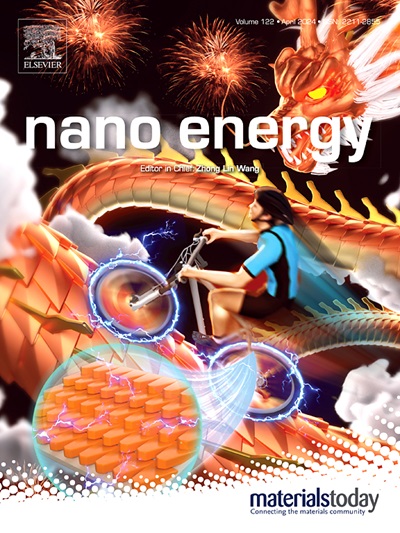Polymer-based solid electrolyte with ultra thermostability exceeding 300 °C for high-temperature lithium-ion batteries in oil drilling industries
IF 16.8
1区 材料科学
Q1 CHEMISTRY, PHYSICAL
引用次数: 0
Abstract
High-temperature lithium-ion batteries (HLBs) are a crucial component in logging while drilling (LWD) equipment, facilitating the date acquisition, analysis, and transmission in myriametric deep formation. Conventional batteries are unable to guarantee a reliable power supply for LWD operations in extreme high-temperature conditions encountered at depths exceeding 10,000 m. Moreover, the development of dedicated batteries for these applications is progressing at a relatively slow pace. In light of these considerations, we put forth a novel proposal: a composite solid-state electrolyte (CSE) for HLB. Poly (ether ether ketone) (PEEK) nanofiber membranes, which are thermally stable at temperatures exceeding 350 °C, were prepared and subsequently composited with Li7La3Zr2O12 (LLZO) by the vacuum filtration method. At room temperature, the PEEK-LLZO composite exhibits ionic conductivity of 1.11 mS·cm ⁻1 and demonstrates stability in lithium-lithium symmetric cells for up to 3500 h. The initial discharge specific capacity was recorded at 132.9 mAh·g ⁻1 at 0.5 C rate, declining to 86.6 % after 500 cycles. Density Functional Theory (DFT) simulations were employed to elucidate the lithium-ion transport mechanisms within the CSE system. It is noteworthy that the CSE displays remarkable thermal stability, with a performance threshold exceeding 300 °C. The ionic conductivity of the CSE system reaches 2.40 mS·cm ⁻1 at 250 °C, representing a twofold increase compared to the LLZO system and an elevenfold increase compared to the LiTFSI molten salt system. Moreover, the initial discharge specific capacity of the CSE was determined to be 123.3 mAh·g ⁻1 at 250 °C and a 1 C rate, retaining 92.8 % of its capacity after 50 cycles. These findings suggest that the CSE exhibits high safety, excellent cycling stability, and considerable potential for application in high-temperature lithium-ion batteries.

聚合物基固体电解质具有超过 300 °C 的超耐热性,可用于石油钻探行业的高温锂离子电池
高温锂离子电池(HLB)是边钻井边测井(LWD)设备的重要组成部分,有助于在测深地层中采集、分析和传输数据。传统电池无法保证在深度超过 10,000 米的极端高温条件下为 LWD 作业提供可靠的电源。此外,针对这些应用的专用电池开发进展相对缓慢。有鉴于此,我们提出了一项新建议:用于 HLB 的复合固态电解质(CSE)。我们制备了在温度超过 350 °C 时具有热稳定性的聚(醚醚酮)(PEEK)纳米纤维膜,随后采用真空过滤法将其与 Li7La3Zr2O12(LLZO)复合在一起。室温下,PEEK-LLZO 复合材料的离子电导率为 1.11 mS-cm -1 ,在锂-锂对称电池中可稳定使用长达 3500 小时。在 0.5 C 的速率下,初始放电比容量为 132.9 mAh-g -1 ,500 个循环后降至 86.6%。密度泛函理论(DFT)模拟用于阐明 CSE 系统内的锂离子传输机制。值得注意的是,CSE 具有显著的热稳定性,性能阈值超过 300 °C。CSE 系统的离子电导率在 250 °C 时达到 2.40 mS-cm -1 ,与 LLZO 系统相比提高了两倍,与 LiTFSI 熔盐系统相比提高了 11 倍。此外,在 250 °C 和 1 C 速率条件下,CSE 的初始放电比容量被测定为 123.3 mAh-g -1 ,在循环 50 次后仍能保持 92.8% 的容量。这些研究结果表明,CSE 具有很高的安全性和出色的循环稳定性,在高温锂离子电池中具有很大的应用潜力。
本文章由计算机程序翻译,如有差异,请以英文原文为准。
求助全文
约1分钟内获得全文
求助全文
来源期刊

Nano Energy
CHEMISTRY, PHYSICAL-NANOSCIENCE & NANOTECHNOLOGY
CiteScore
30.30
自引率
7.40%
发文量
1207
审稿时长
23 days
期刊介绍:
Nano Energy is a multidisciplinary, rapid-publication forum of original peer-reviewed contributions on the science and engineering of nanomaterials and nanodevices used in all forms of energy harvesting, conversion, storage, utilization and policy. Through its mixture of articles, reviews, communications, research news, and information on key developments, Nano Energy provides a comprehensive coverage of this exciting and dynamic field which joins nanoscience and nanotechnology with energy science. The journal is relevant to all those who are interested in nanomaterials solutions to the energy problem.
Nano Energy publishes original experimental and theoretical research on all aspects of energy-related research which utilizes nanomaterials and nanotechnology. Manuscripts of four types are considered: review articles which inform readers of the latest research and advances in energy science; rapid communications which feature exciting research breakthroughs in the field; full-length articles which report comprehensive research developments; and news and opinions which comment on topical issues or express views on the developments in related fields.
 求助内容:
求助内容: 应助结果提醒方式:
应助结果提醒方式:


